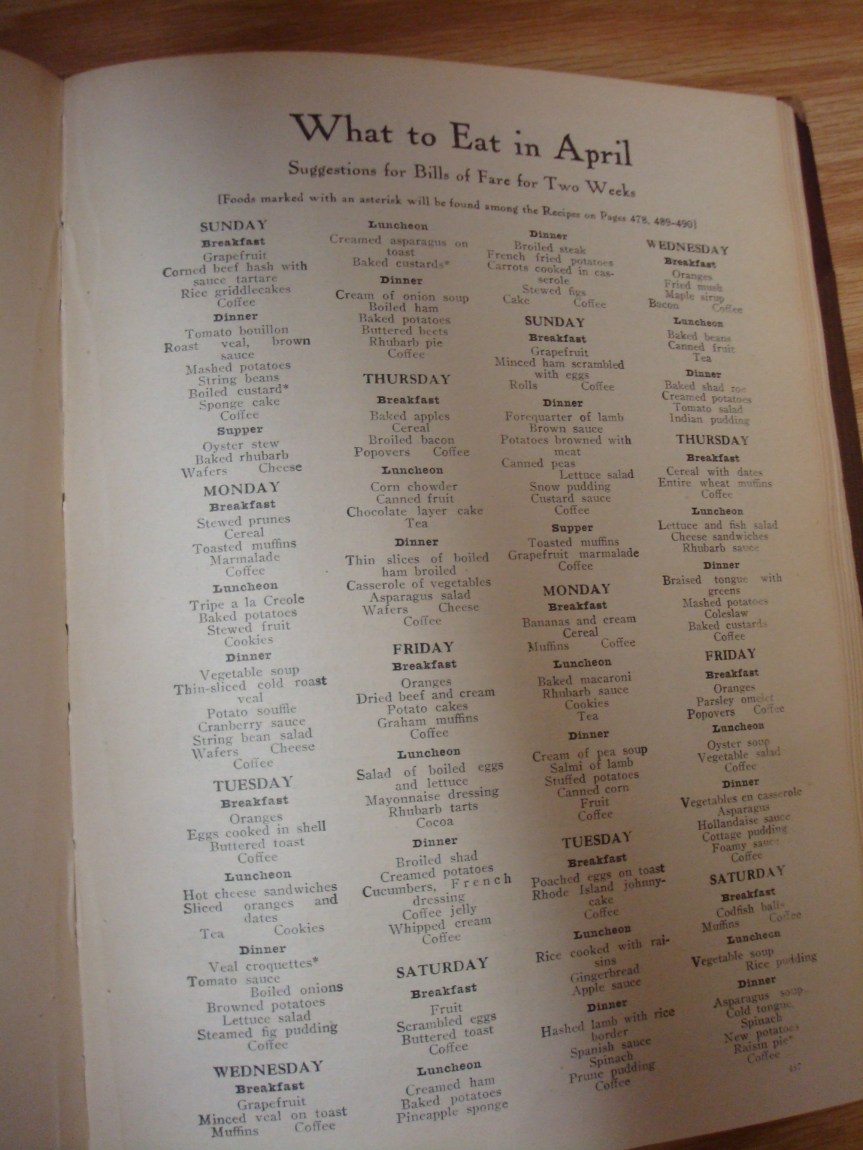16-year-old Helena Muffly wrote exactly 100 years ago today:
Sunday, April 30, 1911: Pa and Ma and Jimmie went away today. Ruth had invited Helen Wesner and Blanche Bryson to come and do justice to her very excellent cooking. I rode home from Sunday school with them. I choked at the dinner table which displayed my most excellent manners.
Her middle-aged granddaughter’s comments 100 years later:
It sounds like Grandma’s sister Ruth had fun cooking a meal for friends—and that Grandma displayed her sense of humor by pretending to choke on the food. A few days ago (see the April 25 and April 27 postings) two of my cousins shared memories about how much Grandma enjoyed practical jokes when she was an older woman. I can now see that this was a trait that she had throughout her life.

I wonder what her sister Ruth cooked. A hundred years ago Good Housekeeping magazine included sample menus each month. One of the April, 1911 Sunday dinner menus is below:
Sunday Dinner
Tomato bouillon
Roast veal, brown sauce
Mashed potatoes
String beans
Boiled custard*
Sponge cake
Coffee
An asterisk meant that the magazine contained the recipe. For the Sunday dinner menu, the only included recipe was for Boiled Custard:
Boiled Custard
Scald one pint of milk in a double boiler. Unless for some special reason milk should always be scaled, not boiled.
Beat the yolks of two eggs, or one whole egg, very light with two tablespoonfuls of sugar; and when the milk has scalded, pour it slowly on to the eggs and sugar, stirring all the while. The milk is added to the eggs and sugar instead of these being added to it, for two reasons. The slow addition of a small amount of hot liquid cools the egg, already divided by the beating in of the sugar, without coagulating it until it is so hard that it separates and permits the custard to separate. Also, in this way all of the egg and sugar is mixed with the milk. When an attempt is made to add adds to milk it is difficult, especially with a small amount, to clean out the dish properly. A little lost with small proportions may spoil or deduce the deliciousness of the dish.
Return the milk, eggs and sugar to the double boiler and cook for three minutes, stirring slowly, but steadily and carefully. A minute’s carelessness here may spoil the custard. If not sufficiently cooked the custard will have a raw “eggy” taste, and a minute too long cooks the egg too hard and the custard seemingly curdles. As soon as the custard coats the spoon, or as soon as it begins to feel thicker as one stirs, add the salt. [Note: I used ½ teaspoon salt.] Strain into a cool dish and flavor with a teaspoonful of vanilla. Properly made, the custard will be smooth and the consistency of rich cream.
I made this recipe using a sauce pan since I don’t own a double boiler, and it turned out fine.
The stirred custard had a nice flavor—but the recipe directions are definitely right when it says that the custard has the consistency of rich cream. As I look back at the menu in the old magazine, I see that it also lists sponge cake. After seeing the consistency of the Stirred Custard, I now think that it may have been used as a sauce on the cake.

A lovely pouring custard recipe that I will try! I love a good pouring custard any day! We like to serve it with crisps or crumbles! MMMMM!
I like your suggestion to serve with crisps or crumbles. I’m going to give it a try.
It is super Yummy! 😀